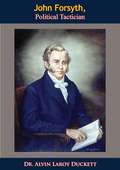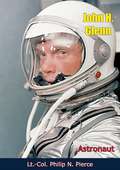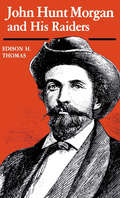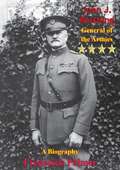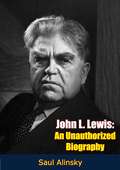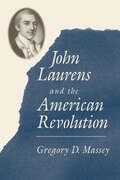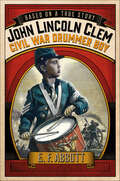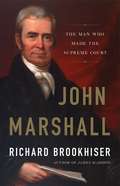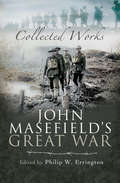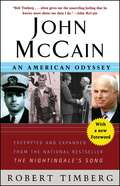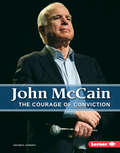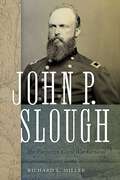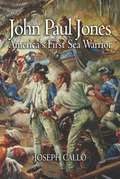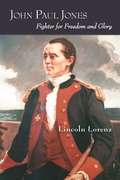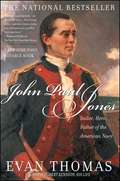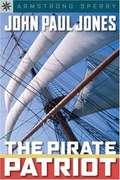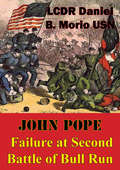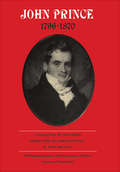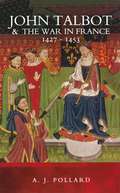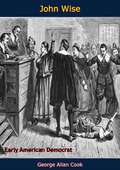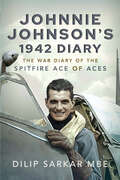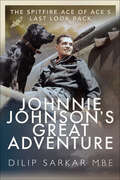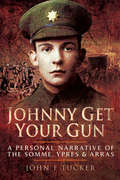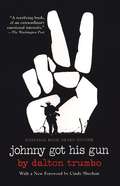- Table View
- List View
John Forsyth: Political Tactician
by Dr Alvin Laroy DuckettFirst published in 1962, this is a biography of John Forsyth (1780-1841), who was Governor of Georgia and Secretary of State under both Andrew Jackson and Martin Van Buren. Alvin Laroy Duckett chronicles Forsyth’s achievements portraying him as one of Georgia’s most versatile and accomplished politicians.Forsyth was elected Attorney General of Georgia at the age of 28, the first public office he held. He went on to serve as U.S. Representative, Senator, and as a Minister to Spain. He was a leader among a group of southern republicans that helped to win the presidency for Andrew Jackson. Forsyth fought nullification, oversaw the government’s response to the Amistad case, and led the pro-removal reply to the Indian Removal Act of 1830. Though he worked primarily at the federal level, Forsyth also contributed greatly to the development of Georgia during his career.
John H. Glenn, Astronaut
by Lt.-Col. Philip N. PierceAT 9:47 on the morning of February 20, 1962, American life came to a breathless halt as millions paused to listen and watch while a mighty rocket hurled a man-carrying capsule into orbit around the earth.The successful flight and safe return of Marine Astronaut Lt.-Col. John Herschel Glenn, Jr., have given his name a luster that few other American names have ever achieved.But John Glenn is more than a name. He is a dedicated maker of history who modestly believes that his God-given talents, and his ability and opportunity to use them, are his destiny—indeed his duty to his country and the world.Here, written by men who know him, is the biography of that remarkable man and his historic flight.
John Hunt Morgan and His Raiders
by Edison H. ThomasThis lively Civil War biography presents an unbiased chronicle of the controversial Confederate General who led the 2nd cavalry in Morgan&’s Raid. Whether one thinks of him as a dashing cavalier or shameless horse thief, it is impossible not to regard John Hunt Morgan as a fascinating Civil War figure. Morgan led his men into the most dangerous adventures by convincing them that the honor of the South was at stake; yet he did not always heed his own sense of honor when temptations of easy theft drew the Raiders from military objectives to wanton pillage. In John Hunt Morgan and his Raiders, Edison H. Thomas gives us a balanced view of these controversial men and their raids, including rare insight into their disruption of rail communications. In a fast-paced narrative he follows the cavalry unit from the evening they set out to join the Confederate forces to the morning of Morgan's death in Greeneville, Tennessee. Basil Duke, St. Leger Grenfell, Lightning Ellsworth, and the beautiful Martha Ready all receive their due, as does the truly remarkable story of the Raiders' newspaper.
John J. Pershing: A Biography (History Of The United States Ser.)
by Frederick PalmerThis is the authoritative biography on General of the Armies John Joseph “Black Jack” Pershing (1860-1948), a senior United States Army officer during World War I. His most famous post was serving as the commander of the American Expeditionary Forces (AEF) on the Western Front from 1917-1918.In John J. Pershing: General of the Armies, author Frederick Palmer focuses primarily on General Pershing’s experiences as Commander of the AEF of the First World War. Here is a biography, history and a tribute to a great general, written by a World War I correspondent who served on his staff. Palmer traces his background, his boyhood in Missouri, his switch from law to West Point, later taking law and teaching at the University of Nebraska, fighting Indians, and Moros, serving in the Spanish-American War, the troubles in Mexico, and his promotion to Brigadier-General. Then the First World War, in minute detail—battles, campaigns, offensives, planning and strategy; conferences with other war leaders; insistence on high stands of discipline and morale; determination on separate American troops; his vision, insight, and gift for organization.An invaluable addition to any WWI library!
John L. Lewis: An Unauthorized Biography
by Saul AlinskyDramatically, from personal acquaintance and Lewis’s own files, Saul Alinsky writes here the inside story of one of the most powerful men in America. Its revelations of why Lewis broke with Roosevelt, of why he fought with the AF of L to form the CIO, of the birth of the sit-down strikes, of the motives behind the war strikes, of how Lewis has so often managed to stalemate the U.S. Government—these are front-page news. They are brought out with sharp insight by one of the most brilliant observers of the labor movement in this country.John L. Lewis is not only reporting of an extremely high order but one of the most stimulating biographies that have been published in many years. There is no one of us who can remain unaffected by the acts of the mine workers’ president.
John Laurens and the American Revolution
by Gregory D. MasseyAn &“excellent biography&” of General Washington&’s aide-de-camp, a daring soldier who advocated freeing slaves who served in the Continental Army (Journal of Military History). Winning a reputation for reckless bravery in a succession of major battles and sieges, John Laurens distinguished himself as one of the most zealous, self-sacrificing participants in the American Revolution. A native of South Carolina and son of Henry Laurens, president of the Continental Congress, John devoted his life to securing American independence. In this comprehensive biography, Gregory D. Massey recounts the young Laurens&’s wartime record —a riveting tale in its own right —and finds that even more remarkable than his military escapades were his revolutionary ideas concerning the rights of African Americans. Massey relates Laurens&’s desperation to fight for his country once revolution had begun. A law student in England, he joined the war effort in 1777, leaving behind his English wife and an unborn child he would never see. Massey tells of the young officer&’s devoted service as General George Washington&’s aide-de-camp, interaction with prominent military and political figures, and conspicuous military efforts at Brandywine, Germantown, Monmouth, Newport, Charleston, Savannah, and Yorktown. Massey also recounts Laurens&’s survival of four battle wounds and six months as a prisoner of war, his controversial diplomatic mission to France, and his close friendship with Alexander Hamilton. Laurens&’s death in a minor battle in August 1782 was a tragic loss for the new state and nation. Unlike other prominent southerners, Laurens believed blacks shared a similar nature with whites, and he formulated a plan to free slaves in return for their service in the Continental Army. Massey explores the personal, social, and cultural factors that prompted Laurens to diverge so radically from his peers and to raise vital questions about the role African Americans would play in the new republic. &“Insightful and balanced . . . an intriguing account, not only of the Laurens family in particular but, equally important, of the extraordinarily complex relationships generated by the colonial breach with the Mother Country.&” —North Carolina Historical Review
John Lincoln Clem: Civil War Drummer Boy (Based On A True Story Ser.)
by E. F. AbbottWould you ever run off to join the army, leaving your family behind? That's what nine-year-old John Lincoln Clem does in 1861. Determined to fight for his country, Johnny sneaks onto a train filled with men from the 3rd Ohio Union Regiment. Taken in by the older soldiers, Johnny becomes a drummer boy, and later, takes up his own musket. As the war rages on, Johnny experiences the brutalities of battle as well as the rampant illness and gnawing hunger in between. But the most dangerous part of Johnny’s journey is yet to come. Based on a True Story books are exciting historical fiction about real children who lived through extraordinary times in American History. This title has Common Core connections.
John M. Schofield and the Politics of Generalship
by Donald B. ConnellyIn the first full biography of Lieutenant General John McAllister Schofield (1831-1906), Donald B. Connelly examines the career of one of the leading commanders in the western theater during the Civil War. In doing so, Connelly illuminates the role of politics in the formulation of military policy, during both war and peace, in the latter half of the nineteenth century.Connelly relates how Schofield, as a department commander during the war, had to cope with contending political factions that sought to shape military and civil policies. Following the war, Schofield occupied every senior position in the army--including secretary of war and commanding general of the army--and became a leading champion of army reform and professionalism. He was the first senior officer to recognize that professionalism would come not from the separation of politics and the military but from the army's accommodation of politics and the often contentious American constitutional system. Seen through the lens of Schofield's extensive military career, the history of American civil-military relations has seldom involved conflict between the military and civil authority, Connelly argues. The central question has never been whether to have civilian control but rather which civilians have a say in the formulation and execution of policy.
John Marshall: The Man Who Made the Supreme Court
by Richard BrookhiserThe life of John Marshall, Founding Father and America's premier chief justice In 1801, a genial and brilliant Revolutionary War veteran and politician became the fourth chief justice of the United States. He would hold the post for 34 years (still a record), expounding the Constitution he loved. Before he joined the Supreme Court, it was the weakling of the federal government, lacking in dignity and clout. After he died, it could never be ignored again. Through three decades of dramatic cases involving businessmen, scoundrels, Native Americans, and slaves, Marshall defended the federal government against unruly states, established the Supreme Court's right to rebuke Congress or the president, and unleashed the power of American commerce. For better and for worse, he made the Supreme Court a pillar of American life. In John Marshall, award-winning biographer Richard Brookhiser vividly chronicles America's greatest judge and the world he made.
John Masefield's Great War: Collected Works
by John MasefieldJohn Masefield wrote four books on The Great War: Gallipoli, The Old Front Line, War and the Future and Battle of the Somme. These have been acclaimed as perceptive and beautiful crafted works, which bring home the full horror and hopelessness of war. This is the first opportunity for historians and general readers to purchase all four in a handsome yet reasonably priced volume, which is definitely a collectable. In addition there is a full introduction by Dr. Philip Errington, the leading Masefield authority who is head of Sotheby's Department of Printed Books and Manuscripts. This rare collection is rounded off by a selection of shorter pieces by the hugely popular Poet Laureate.
John McCain: An American Odyssey
by Robert TimbergRobert Timberg, an award-winning Washington journalist, is a 1964 U. S. Naval Academy graduate and a Marine veteran of the Vietnam war. He was The Baltimore Sun's White House correspondent during the Reagan presidency.
John McCain: The Courage of Conviction (Gateway Biographies Ser.)
by Heather E SchwartzThis timely title examines the remarkable life and death of John McCain, from his time as a decorated war veteran to elder statesman. Accessible text and plentiful photos cover McCain's early life, his military career, his political legacy, and his 2017 diagnosis of brain cancer. Up-to-the-minute details round out this latest look at a uniquely American figure.
John P. Slough: The Forgotten Civil War General
by Richard L. MillerJohn Potts Slough, the Union commander at the Battle of Glorieta Pass, lived a life of relentless pursuit for success that entangled him in the turbulent events of mid-nineteenth-century America. As a politician, Slough fought abolitionists in the Ohio legislature and during Kansas Territory&’s fourth and final constitutional convention. He organized the 1st Colorado Volunteer Infantry after the Civil War broke out, eventually leading his men against Confederate forces at the pivotal engagement at Glorieta Pass. After the war, as chief justice of the New Mexico Territorial Supreme Court, he struggled to reform corrupt courts amid the territory&’s corrosive Reconstruction politics.Slough was known to possess a volcanic temper and an easily wounded pride. These traits not only undermined a promising career but ultimately led to his death at the hands of an aggrieved political enemy who gunned him down in a Santa Fe saloon. Recounting Slough&’s timeless story of rise and fall during America&’s most tumultuous decades, historian Richard L. Miller brings to life this extraordinary figure.
John Paul Jones
by Joseph CalloThis fresh look at America's first sea warrior avoids the hero worship of past biographies and provides a more complete understanding of his accomplishments. Writing from the perspective of a naval officer with more than thirty years of experience and a seaman with a lifetime of sailing know-how, Callo examines Jones' extraordinary career by going beyond his legendary naval achievements to establish him as a key player in the American Revolution. Analyzing his relationships with important civilian leaders of the Revolution, such as Benjamin Franklin, the author demonstrates how Jones' handling of those often difficult dealings contributed to the nation's concept of civilian control of the military. In this acclaimed biography, Jones is shown to be not only a highly-skilled and relentless commander, but the first serving American naval officer to emphasize the role the Navy could play in the rise of the United States as a global power.
John Paul Jones
by Lincoln LorenzThis is the true life story of the Scottish gardener's son, John Paul, who became America's greatest naval hero, John Paul Jones. British midshipman, African slaver, traveling actor, merchant captain, accused of murder and suspected of freebooting-this was John Paul. Captain in Washington's Continental Navy, raider of the British coasts and victor in one of history's most desperate naval battles, lion of the French court and beloved by beautiful women, Russian admiral under Catherine the Great, and dead at 45, neglected by his adopted United States, his very grave lost for a hundred years-that was John Paul Jones.
John Paul Jones: Sailor, Hero, Father of the American Navy
by Evan ThomasRelive the American Revolution in this gripping biography of sailor John Paul Jones, remembered as the father of the American Navy.
John Paul Jones: The Pirate Patriot
by Armstrong SperryNewbery Medalist Armstrong Sperry tells the exciting story of the man who led a rag-tag continental navy to victory at sea.
John Pope - Failure At Second Battle Of Bull Run
by LCDR Daniel B. Morio USNWas the failure of the Army of Virginia at the Second Battle of Bull Run a result of General John Pope being a failure as a leader or were there other circumstances that helped him in his loss?General Pope had a long career in the Army that to the Second Battle of Bull Run had gone well. Pope had distinguished himself in the Mexican-American War and had done well early on in the western theater of operations during the Civil War. With his assumption of command in northern Virginia, Pope entered a realm in which he was unfamiliar, not welcomed by the troops he led and out of his league with regards to the Confederate leaders arrayed against him.Pope's paranoia regarding commanders who had come from General George McClellan's Army of the Potomac resulted in a lack of trust in first-hand accounts from senior officers as well as intelligence presented. This lack of trust resulted in his disregarding the fact that General Lee and Longstreet had moved 25,000 Confederate soldiers through Thoroughfare Gap and combined forces with General Jackson and deployed them along the right flank of Jackson's forces and perpendicular to Pope's force. This force than proceeded to assail the Union flank to nearly disastrous proportions.The fog of war has clouded the judgment of many generals throughout history and Pope was no exception. The fog of war negatively affected his imagination and ability to think critically throughout the battle.
John Prince 1796-1870: A Collection of Documents
by R. Alan DouglasJohn Prince was a lawyer, farmer, military officer, politician, judge, and entrepreneur. Born at Hereford, England, in 1796, he emigrated to Upper Canada in 1833 because he was ashamed of his ne'er-do-well father. His interest in farming took him to Sandwich where he became involved in the many careers open to him. An unhappy and volatile man, he was constantly at odds with himself, his family, and his associates. As colonel of the Third Essex Regiment, he was sometimes unpredictable in his actions and on one occasion, during the Upper Canada Rebellion, unjustifiably violent – ordering the summary execution of five prisoners after the Battle of Windsor. As a politician, despite his haughty and melancholic nature and his erratic individualism, he held the loyalty of his constituents, representing Essex in the House of Assembly from 1836 to 1854 and the Western Districts in the Legislative Council from 1856 to 1860. In 1860, after a lifetime spent in politics, farming, railroading and mining speculations, and canal schemes, he obtained a long-sought judgeship in the new District of Algoma. Leaving his wife and children behind, he went off to his 'New Siberia,' where he continued his restless struggle to escape 'the importunities of mankind,' and where his long, tragic life ended in 1870. Entries from Prince's diary, excerpts from newspaper accounts, and letters give a vivid picture of the politics and life of his time. In his Introduction, R. Alan Douglas emphasizes the contribution made by the discovery of the diary to our perception of the people, places, and events of mid-nineteenth century North America. (Ontario Series of the Champlain Society, 11)
John Talbot & the War in France, 1427–1453
by A. J. PollardJohn Talbot, Earl of Shrewsbury was the last of the celebrated English commanders of the Hundred Years' War. In his lifetime his reputation for audacity and courage gave him an unrivalled fame among the English, and he was feared and admired by the French. A.J. Pollard, in this pioneering and perceptive account, reconstructs the long career of this extraordinary soldier and offers a fascinating insight into warfare in the late medieval period. Talbot was the last representative of generations of brave, brutal warriors whose appetite for glory and personal gain had sustained English policy in France since the time of Edward III. His defeat and death at the Battle of Castillon on 17 July 1453 marked the end of the wars. It was also the final act in a heroic but savage tradition.
John Wise: Early American Democrat
by George Allan CookA biography of the 17th to 18th century reverend and New England political figure John Wise, who lead his town in protest against an arbitrarily imposed tax, acted as spokesman for one of the earliest 'No taxation without representation' challenges, petitioned for two of the most vigorously prosecuted victims in the Salem witch trials, and who advocated many other causes during his life.
Johnnie Johnson's 1942 Diary: The War Diary of the Spitfire Ace of Aces
by Dilip SarkarA unique insight into how fighter pilots lived, loved—and died—through the diary of the top-scoring RAF Ace who survived the Battle of Britain. A one-time household name synonymous with the superlative Spitfire, Air Vice-Marshal &“Johnnie&” Johnson&’s aerial combat successes of World War II inspired schoolboys for generations. As a &“lowly Pilot Officer,&” Johnson learned his fighter pilot&’s craft as a protégé of the legless Tangmere Wing Leader, Douglas Bader. After Bader was brought down over France and captured on 9 August 1941, Johnnie remained a member of 616 (South Yorkshire) Squadron. By the beginning of 1942, when Johnnie&’s diary begins, Fighter Command was pursuing an offensive policy during daylight hours, &“reaching out&” and taking the war to the Germans in France. It was also a period in which the Focke-Wulf Fw outclassed the Spitfire Mk.V. In Johnnie&’s words, the Fw 190 &“drove us back to the coast and, for the first time, pilots lost confidence in the Spitfire.&” As well as his participation in Rhubarb and Circus sorties, Johnnie was also involved in Operation Jubilee on 19 August 1942. In this diary, published here for the first time, we get a glimpse of the real Johnnie, and what it was really like to live and breathe air-fighting during one of the European air war&’s most interesting years: 1942. Presented on a day-by-day basis, each of Johnnie&’s entries is supported by an informative narrative written by the renowned aviation historian Dilip Sarkar, drawing upon official documents and his interviews and correspondence with the great man. &“Provides a number of insights into life in the RAF Fighter Command of that period.—Most Highly Recommended.&” —Firetrench
Johnnie Johnson's Great Adventure: The Spitfire Ace of Ace's Last Look Back
by Dilip SarkarThe World War II fighter Ace&’s previously unpublished draft—an account of the &“Long Trek&” from Normandy into the heart of the Third Reich itself. Having published two of his own books, Wing Leader and The Circle of Air Fighting, Air Vice-Marshal Johnnie Johnson co-authored several more with another fighter ace, namely Wing Commander P.B. &“Laddie&” Lucas. In 1997, the &“AVM&” suggested to his friend, the prolific author Dilip Sarkar, that the pair should collaborate on The Great Adventure. &“Greycap Leader&” was to produce a draft, after which Dilip would add the historical detail and comment. Sadly, the project was unfulfilled, because Johnnie became ill and passed away, aged eighty-five, in 2001. Years later, Johnnie&’s eldest son, Chris, discovered the manuscript among his august father&’s papers. In order to keep Johnnie&’s memory evergreen, Chris turned to Dilip to finally see the project through to its conclusion. In this book Johnnie revisits certain aspects of his wartime service, including the development of tactical air cooperation with ground forces; his time as a Canadian wing leader in 1943, when the Spitfire Mk IX at last outclassed the Fw 190; and details his involvement in some of the most important battles of the defeat of Nazi Germany, including Operation Overlord and the D-Day landings in 1944, Operation Market Garden and the airborne assault at Arnhem, and the Rhine Crossings, throughout all of which Johnnie also commanded Canadian wings. Johnnie Johnson&’s Great Adventure &“brings to life the man of the book in such an interesting and heroic manner . . . if it wasn&’t for these brave heroes we might not have won the war&” (UK Historian).
Johnny Get Your Gun: A Personal Narrative of the Somme, Ypres & Arras
by John F. TuckerAt the age of seventeen-and-a-half, full of idealism and patriotism, John Tucker enlisted as an Infantryman in the London Kensington Regiment and reached France, after training, in August 1915. Against all odds he survived three years of bitter trench warfare, was seriously wounded, and returned to Blighty a few months before Armistice Day. During those years he took part in the Battle of the Somme, the battles of Arras and Cambrai, and the Third Battle of Ypres. Yet though his patriotism remained unflinching, his idealism gave way to the grim realities of day to day survival in the trenches and, as he began to understand what constitutes courage, he grew from boyhood to manhood.The author contrasts the beauties of the French countryside with the ugliness of widespread death and destruction, and paints a picture of French country life hardly less squalid than the soldiers' own lot. But above all, he makes the reader realise what it was like to fight in the war to end all wars.These are the memoirs of one Infantryman, but through his eyes a vivid canvas of the whole war gradually unfolds.
Johnny Got His Gun: Johnny Cogió Su Fusil (Film Ink Ser.)
by Dalton TrumboThe Searing Portrayal Of War That Has Stunned And Galvanized Generations Of ReadersAn immediate bestseller upon its original publication in 1939, Dalton Trumbo?s stark, profoundly troubling masterpiece about the horrors of World War I brilliantly crystallized the uncompromising brutality of war and became the most influential protest novel of the Vietnam era. Johnny Got His Gun is an undisputed classic of antiwar literature that?s as timely as ever.?A terrifying book, of an extraordinary emotional intensity.?--The Washington Post"Powerful. . . an eye-opener." --Michael Moore"Mr. Trumbo sets this story down almost without pause or punctuation and with a fury amounting to eloquence."--The New York Times"A book that can never be forgotten by anyone who reads it."--Saturday Review
